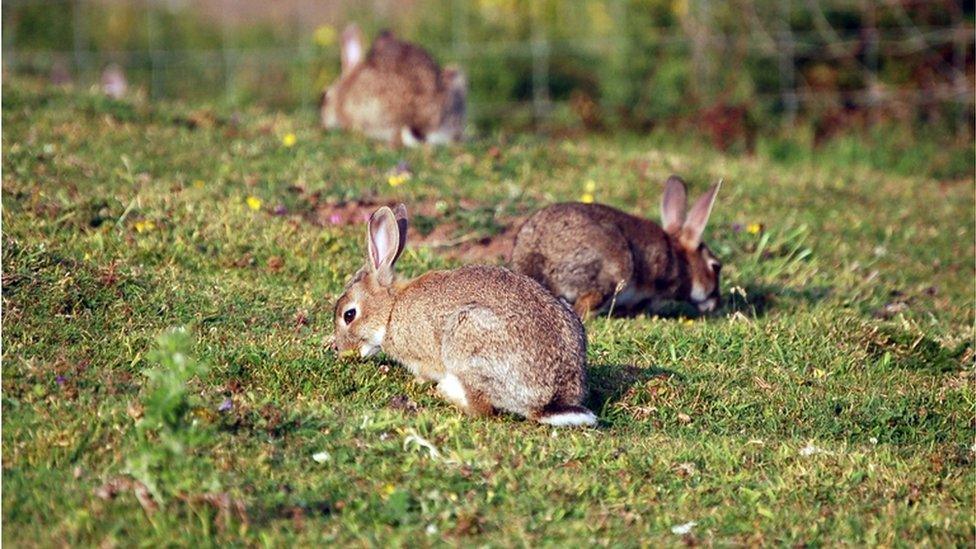Contagious virus deadly to rabbits and hares found in NI
- Published

RHDV2 was detected in two rabbits tested last month
A virus which is potentially deadly to rabbits has been discovered in animals in Northern Ireland.
Rabbit Haemorrhagic Disease Virus Two (RHDV2) was detected in samples from two rabbits which were submitted for testing on 23 June.
Testing was carried out by the government-supported Agri-Food and Biosciences Institute (AFBI).
While the disease is contagious between rabbits, it cannot be spread to humans.
Neil Reid, an senior lecturer in conservation biology at Queen's University, said it was likely the disease was widespread across the island of Ireland.
A spokesperson for the Department of Agriculture, Environment, and Rural Affairs (DAERA) said the disease had also been detected during testing in 2019, with one sample returning a positive result out of three rabbits which were submitted under passive surveillance.
Passive surveillance refers to a system where cases are brought to the attention of the department by people dealing with animals, rather than the disease being searched for.
It was the first time the virus had been discovered in Northern Ireland. It was also found in the Republic of Ireland last year, external.
In a response to a parliamentary question, external, the then Irish Minister for Culture, Heritage, and the Gaeltacht Josepha Madigan said the virus is "known to be highly contagious" and that "environmental contamination presents significant difficulties in terms of any biosecurity responses".
Falling rabbit numbers
Speaking to BBC News NI, Dr Reid said: "We have poor data by which to track change in rabbit and hare numbers in Ireland but mammal sightings during the Breeding Bird Survey (BBS) by the British Trust for Ornithology (BTO) suggest rabbits may have declined by 32% in Northern Ireland and 64% in Great Britain since the mid-1990s.
"Irish hares are also susceptible to RHDV2. Their numbers declined substantially throughout the 20th Century and are now comparatively low at three hares per km squared."
Dr Reid said the decline in numbers was likely due to a combination of factors, including other diseases like myxomatosis in rabbits, land use change, farming practices and potentially climate change.
"We don't know the demographic impact of RHDV2 on rabbit and hare populations in Ireland as it has only been detected recently, but there is evidence of further localised declines in numbers in Great Britain," he said.
"Rabbits and hares sit in the middle of the food chain and would be eaten by many predators, so change in their numbers has ecological consequences.
"RHDV2 infected rabbits may die in their warrens and may not be found, whilst people finding carcasses aboveground may not necessarily submit them for testing as few are aware of the disease.
"I suspect RHDV2 is present throughout Ireland and is likely to have been present before recent detections."

What is RHDV2?
Rabbit Haemorrhagic Disease Virus, the virus from which this strain is derived, was first discovered in China in 1984.
According to the World Organisation for Animal Health, external (OIE), RHDV2 was first found in France in 2010, and has become the prevalent strain of Rabbit Haemorrhagic Disease in Europe.
In the 10 years since the discovery of RHDV2 it has "rapidly spread to Europe and Mediterranean basin causing significant losses in farmed and wild rabbits in many countries".
Symptoms may include lethargy, loss of weight, and bleeding from the nose and mouth.
The virus is known to spread in both domestic and wild rabbits, and has also been found to have jumped species to hares.
Last year, the disease was linked to the deaths of hares in England.

'Look for symptoms'
A spokesperson for DAERA told BBC News NI that RHDV2 is not a notifiable disease in Northern Ireland - meaning by law it is not required to be reported to the department, external.
"As such, there is no active surveillance programme undertaken by the department," the spokesperson said.
"However, given it is an World Organisation for Animal Health notifiable disease, should RHDV2 be confirmed through passive surveillance or reporting, DAERA reports it to OIE.
"Members of the public, particularly farmers, landowners, vets and pet owners are asked to be alert to any signs of disease in animals and should advise local DAERA Divisional Veterinary Office if they suspect any signs of disease in animals."
They added the department would continue to work with colleagues in the Republic of Ireland to monitor the situation.
- Published31 March 2019

- Published26 April 2020
